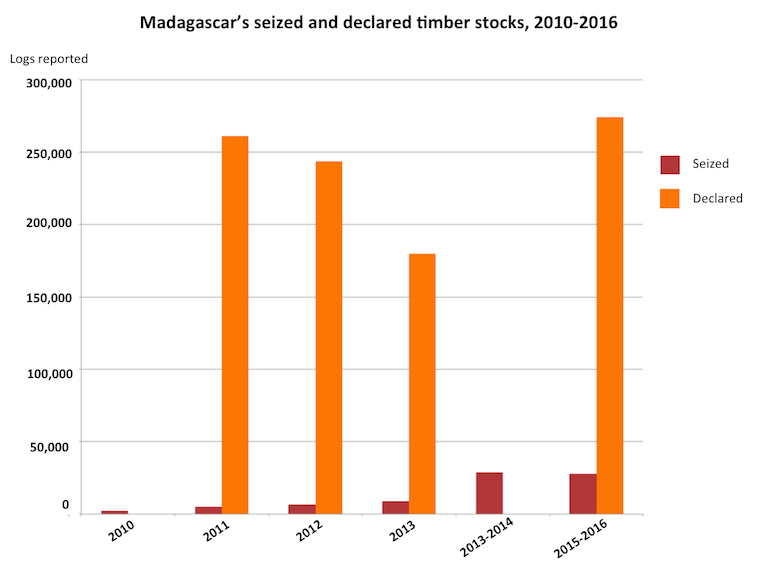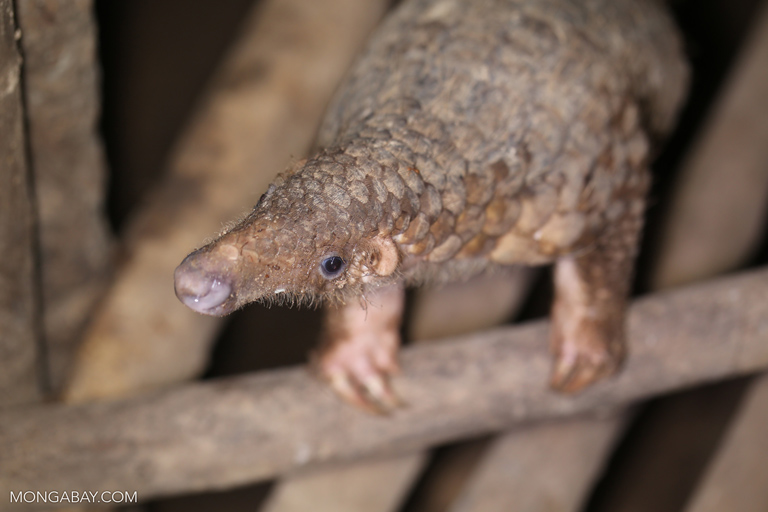- The standing committee of the Convention on International Trade in Endangered Species of Wild Fauna and Flora (CITES) had its annual meeting in Geneva November 27 through December 1.
- The committee rejected Madagascar’s petition to sell its stockpiles of seized rosewood and ebony that had been illegally cut from the country’s rainforests.
- CITES delegates agreed that while a future sale of the stockpiles might be possible, Madagascar was not yet ready for such a risky undertaking, which could allow newly chopped logs to be laundered and traded overseas.
- Other notable outcomes of the CITES meeting dealt with the sei whale (Balaenoptera borealis), pangolins, and the critically endangered vaquita porpoise (Phocoena sinus).
In August, the government of Madagascar drafted a business plan to sell its stockpiles of rosewood and ebony — hundreds of thousands of logs. The plan required the approval of CITES, which has banned the trade of all species of Malagasy rosewood (Dalbergia spp.) and ebony (Diospyros spp.) since 2013.
On December 1 during a five-day meeting of its standing committee in Geneva, CITES rejected the plan because of the government’s lack of progress in tackling the so-called rosewood crisis and its failure, thus far, to audit enough of the stockpiles. Illegal logging of rosewood and other precious timber spiked in Madagascar’s northeastern rainforests, including in national parks, following a 2009 coup. The logging has since declined but the fate of stockpiled wood has remained an open question.
Madagascar’s government controls only a small portion of the stockpiles. Most of the rosewood covered by the business plan is in “declared” stockpiles that remain in the possession of timber traders and have never been fully counted or verified. Most observers believe that timber barons have over-declared the number of logs in their stockpiles so that they can keep adding to them, and that the

stockpiles are now being used as clearinghouses for newly cut, illegal timber. Millions more logs not covered by the government’s sale plan remain in hidden “undeclared” stockpiles around northeast Madagascar, observers believe.
CITES delegates from the United States, the European Union, and various non-governmental organizations were vocal participants in rosewood discussions. These parties agreed that while a future sale of the stockpiles might be possible, Madagascar is not yet ready for such a risky undertaking. If not done carefully, such a sale could allow newly chopped logs to enter the international market. The rosewood issue did not come to a vote, but was decided by consensus.
In the past few years, Malagasy authorities and foreign consultants made several haphazard efforts to audit the stockpiles. Many of the logs now have colored markings from the different audits. These markings are often found on Malagasy rosewood that is seized at international ports, according to conservation NGOs — a sure sign that traffickers are accessing the stockpiles.
“We know that the stockpiles are fluid, and they have been taken from already,” Colman O’Criodain, a policy manager at WWF who attended the CITES meeting told Mongabay. “There have been big seizures of wood that was once in these stockpiles.”

Rosewood, which has a rich crimson interior, is the most trafficked type of wildlife in the world. Almost all of it ends up in China, where it’s used in high-end furniture.
In Madagascar, storage costs are low, but maintaining the stockpiles nonetheless presents major challenges. Traffickers steal from the stockpiles or use them to launder illegal wood, sometimes by swapping out real rosewood logs for pine or eucalyptus. And the longer the wood sits outside government offices or in metal containers, the more its quality diminishes. After a year or two, the wood can grow dry and crack, reducing its value.
At the CITES meeting, Johanita Ndahimananjara, Madagascar’s Minister of Environment, Ecology, and Forests, argued that Madagascar needs to sell the stockpiled rosewood in order to fund its rosewood conservation efforts. Her plan called for Madagascar to buy $7 million worth of rosewood and ebony from the owners of the declared stockpiles and then sell it in a series of international auctions. It is unclear how much Madagascar could earn from the such auctions; the business plan listed potential values ranging from under $5 million to upwards of $136 million.
Almost everyone in the room opposed Madagascar’s plan. Among other issues, conservation groups did not support the plan to pay timber traders $7 million.
“It would undermine the very work they are trying to do” to manage the crisis, Susanne Breitkopf, a forest policy manager at the Environmental Investigation Agency who attended the CITES meeting, told Mongabay.
Breitkopf and O’Criodain both told Mongabay that the only party to support Madagascar’s business plan was in fact the World Bank. But Benjamin Garnaud, a natural resource management specialist for the World Bank who is based in Madagascar and who attended the CITES meeting, told Mongabay that he agreed with the NGOs on the central question at hand: Madagascar is absolutely not ready to sell its stock, he said.
The World Bank is working with Madagascar to set up a stockpile disposal mechanism: the logs must be inspected, graded, marked with anti-counterfeit technology, transported, and ultimately sold or disposed of in another way. To build this mechanism, the World Bank has already loaned Madagascar $3 to $4 million. Garnaud suggested that if the logs don’t end up being sold, they could be used for furniture in Malagasy schools. Madagascar could also burn the logs, as some African countries have done with ivory from elephant tusks.
Last year, CITES declared that Madagascar must audit at least one third of its stockpiles before the ban on the trade of rosewood and ebony could be lifted. But it’s difficult to determine the number of logs in the stockpiles. Garnaud estimates that there are about 30,000 logs in seized government stockpiles, and about 300,000 in declared private stock, but there have been five inventories since 2011, each producing different results. The biggest problem with the “one-third” stipulation, according to Garnaud, is that if Madagascar sold one third of its logs before fully accounting for the rest, it would open the door for timber barons to add newly cut rosewood, or hidden stock, into the “declared” group.
Last week, CITES issued a new recommendation to Madagascar: find and recover the rosewood from the hidden stockpiles. The standing committee also, for the first time, explicitly asked Madagascar to prosecute high-level offenders in the rosewood trade, which the government has not done in recent years.
The next CITES standing committee meeting will be in Russia in October 2018. That will be Madagascar’s next opportunity to petition the body to sell the stockpiles.

Other developments at the CITES meeting
Last week’s standing committee meeting was the largest on record, with more than 500 participants. They discussed a large slate of issues from around the world, including three that garnered particular attention.
Japan came under heavy scrutiny for targeting sei whales (Balaenoptera borealis) in the North Pacific. The whales are listed under Appendix I of CITES, meaning they are threatened with extinction and can only be traded “in exceptional circumstances.” Japan says its whaling program is for research purposes, so the standing committee decided to do more fact-finding before taking further action. Environmental groups were disappointed; they say Japan’s program has killed 134 of the endangered whales so far this year.
Last year, CITES placed a ban on the trade of pangolins, the world’s most trafficked mammals, but at the Geneva meeting, China requested an exemption for stockpiled pangolin scales. The request was voted down almost unanimously. (This was the only issue that came to a vote all week; most CITES decisions are made by consensus.)
In the final action of the week, the United States, Mexico, and China agreed to take steps to protect the vaquita (Phocoena sinus), a small porpoise found only in the Gulf of California. The vaquita is critically endangered, with only around 30 individuals left, due to illegal fishing of totoaba, a critically endangered fish whose swim bladders are often smuggled through the United States en route to China. A high-level CITES mission to Mexico will take place in February.

Banner image: Red ruffed lemur (Varecia rubra), a species that lives in northeastern Madagascar, where rosewood logging has been severe. Photo by Rhett A. Butler.
FEEDBACK: Use this form to send a message to the editor of this post. If you want to post a public comment, you can do that at the bottom of the page.
